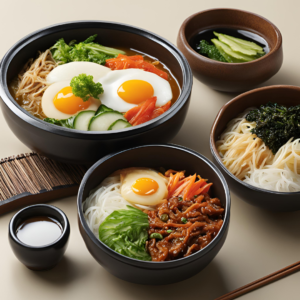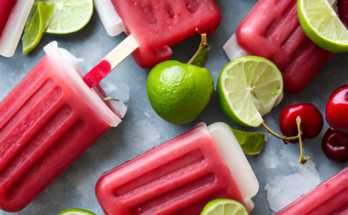Discover Healthy Korean Food: Delicious and Nutritious Dishes!
Korean food is known for its bold flavors and colorful dishes. But did you know that many Korean dishes are also packed with nutrients? Whether you’re looking to eat healthier or simply explore a new cuisine, healthy Korean food offers something for everyone. This guide will walk you through some of the most nutritious options, from hearty soups to refreshing salads. Let’s dive into the delicious world of healthy Korean food!
The Basics of Korean Cuisine
Korean cuisine is built on a few key ingredients. These include rice, vegetables, seafood, and meats. Korean food also uses various fermented foods like kimchi, which is not only tasty but also great for your gut health. The combination of these ingredients makes Korean dishes both flavorful and nutritious.
Why Korean Food is Healthy
Healthy Korean Food is naturally low in calories and high in nutrients. The use of fresh vegetables and lean meats means you’re getting a lot of vitamins and minerals. Additionally, the fermentation process used in foods like kimchi adds probiotics to your diet, which are beneficial for digestion.

Healthy Korean Food
Popular Healthy Korean Food Dishes
1. Bibimbap
Bibimbap is a mixed rice dish that includes a variety of vegetables, an egg, and sometimes lean meat like chicken or beef. The dish is usually seasoned with gochujang, a spicy red pepper paste that adds flavor without adding too many calories. Bibimbap is a well-balanced meal, offering carbs, protein, and plenty of vegetables.
2. Kimchi
Kimchi is a staple in Korean households. This fermented vegetable dish is made primarily from cabbage and radishes. It’s seasoned with garlic, ginger, and chili flakes. Not only is kimchi low in calories, but it’s also rich in vitamins A and C, as well as probiotics that promote a healthy gut.
3. Samgyeopsal
Samgyeopsal is grilled pork belly, often served with a variety of side dishes like lettuce, garlic, and chili peppers. While pork belly might sound fatty, when eaten in moderation and paired with vegetables, it can be a part of a balanced meal. The key is to enjoy it with lots of veggies and to use minimal sauces.
4. Japchae
Japchae is a stir-fried glass noodle dish made from sweet potato starch. It includes vegetables like spinach, carrots, and mushrooms, as well as a protein like beef or tofu. Japchae is low in calories but high in fiber and vitamins, making it a healthy option.
5. Doenjang Jjigae
Doenjang jjigae is a soybean paste stew that is both comforting and nutritious. It usually includes tofu, mushrooms, and various vegetables. The soybean paste used in the stew is rich in protein and probiotics, making it a great option for a healthy meal.
How to Make Healthy Korean Food at Home
Making Korean food at home can be both fun and rewarding. Not only do you get to control the ingredients, but you can also make sure that your meals are as healthy as possible.
1. Use Fresh Ingredients
The key to healthy Korean cooking is using fresh, high-quality ingredients. Choose vegetables that are in season, lean cuts of meat, and natural seasonings like garlic and ginger.
2. Minimize the Use of Oil
While Korean food can involve frying, you can reduce the oil used in cooking to make the dishes healthier. Opt for grilling, steaming, or stir-frying with minimal oil.
3. Limit Sugar and Salt
Some Korean recipes call for sugar or salt to enhance the flavor. You can adjust these to your taste and health needs. Using alternatives like honey or low-sodium soy sauce can help keep your dishes flavorful without compromising on health.
4. Focus on Balance
Korean meals are traditionally balanced, with a mix of carbohydrates, proteins, and vegetables. Keep this balance in mind when cooking at home to ensure your meals are nutritious.
Healthy Korean Snacks and Sides
Korean cuisine isn’t just about main dishes. There are plenty of healthy snacks and sides that you can enjoy throughout the day.
1. Gimbap
Gimbap is a Korean-style sushi roll that’s filled with a variety of ingredients like vegetables, eggs, and sometimes meat or fish. It’s a light, nutritious snack that’s easy to take on the go.
2. O-i Muchim
O-i muchim is a spicy cucumber salad that’s both refreshing and low in calories. It’s seasoned with vinegar, garlic, and chili flakes, making it a perfect side dish or snack.
3. Banchan
Banchan refers to the small side dishes that accompany a Korean meal. These can include anything from seasoned spinach to bean sprouts. Banchan is usually made with minimal oil and seasoning, making it a healthy addition to any meal.
4. Fruit
Koreans love fresh fruit as a dessert or snack. Seasonal fruits like persimmons, pears, and melons are commonly enjoyed, offering a sweet and nutritious treat without added sugars.
Read More: Korean Dishes
Healthy Korean Food for Special Diets
Whether you’re vegetarian, vegan, or gluten-free, Korean cuisine has something to offer.
1. Vegetarian Options
Many Korean dishes are naturally vegetarian or can be easily adapted. For example, bibimbap can be made without meat, and tofu can be used in place of seafood in soups and stews.
2. Vegan Options
Veganism is becoming more popular in Korea, and many traditional dishes are already vegan-friendly. Dishes like kimchi, japchae, and various vegetable stews can be enjoyed without any animal products.
3. Gluten-Free Options
Korean food often uses rice or sweet potato noodles, making it a good choice for those avoiding gluten. Soy sauce can be replaced with tamari, and many traditional dishes like kimchi and grilled meats are naturally gluten-free.
The Role of Fermented Healthy Korean Food Diet
Fermented foods are a big part of Korean cuisine. They’re not just flavorful but also packed with health benefits.
1. Kimchi
As mentioned earlier, kimchi is rich in probiotics, which are great for your digestive health. The fermentation process also increases the bioavailability of vitamins and minerals.
2. Doenjang
Doenjang, or fermented soybean paste, is another staple in Korean cooking. It’s used in soups, stews, and as a seasoning. Doenjang is a good source of protein, vitamins, and probiotics.
3. Gochujang
Gochujang is a fermented red pepper paste used in many Korean dishes. It adds a spicy kick while also offering the benefits of fermentation, including improved digestion and a boost in metabolism.
Eating Healthy Korean Food at Restaurants
If you’re dining out at a Korean restaurant, there are plenty of healthy options to choose from.
1. Grilled Meats
Opt for grilled meats like chicken or fish, which are usually served with a variety of vegetables. This allows you to enjoy a protein-rich meal without the extra calories from frying.
2. Soups and Stews
Korean soups and stews are often packed with vegetables and lean proteins. Choose options like doenjang jjigae or kimchi jjigae for a nutritious and filling meal.
3. Banchan
Take advantage of the banchan that comes with your meal. These small side dishes are often made from vegetables and can add a variety of flavors and nutrients to your meal.
4. Skip the Rice
If you’re watching your carb intake, you can skip the rice or ask for a smaller portion. Instead, fill up on the vegetables and lean proteins offered in the other dishes.
Healthy Korean Food for Weight Loss
Korean cuisine can be a great ally in your weight loss journey.
1. Low-Calorie Options
Many Korean dishes are naturally low in calories, especially those that focus on vegetables and lean meats. Dishes like kimchi, cucumber salad, and grilled fish can be filling without being calorie-dense.
2. High in Fiber
Korean food is often high in fiber, thanks to the use of vegetables and whole grains like brown rice. Fiber helps keep you full longer, reducing the temptation to snack between meals.
3. Portion Control
Korean meals are traditionally served with multiple small dishes, which can help with portion control. Instead of piling everything onto one plate, you can enjoy a little bit of everything.
4. Spicy Foods
Spicy foods like gochujang and kimchi can boost your metabolism, helping you burn more calories throughout the day. Plus, they add flavor without adding too many extra calories.
Incorporating Healthy Korean Food into Your Daily Life
Eating healthy Korean food doesn’t have to be a special occasion. You can easily incorporate these dishes into your daily routine.
1. Breakfast
Start your day with a healthy Korean breakfast. Options like tofu soup, vegetable pancakes, or a small bowl of rice with kimchi can give you the energy you need to kickstart your day.
2. Lunch
For lunch, try a simple bibimbap or a vegetable-packed japchae. These dishes are easy to prepare ahead of time and bring to work or school.
3. Dinner
Dinner can be as simple as a grilled piece of fish with a side of steamed vegetables and a small portion of rice. Add some banchan for variety and extra nutrients.
4. Snacks
Keep healthy Korean snacks on hand, like gimbap or a small portion of spicy cucumber salad. These can keep you satisfied between meals without derailing your healthy eating plan.
Healthy Korean Desserts
Even desserts can be healthy in Korean cuisine.
1. Patbingsu
Patbingsu is a shaved ice dessert topped with sweet red beans and fruit. It’s refreshing and light, especially when made with minimal added sugars.
2. Yakgwa
Yakgwa is a traditional honey cookie made from wheat flour, sesame oil, and honey. It’s sweet but can be enjoyed in moderation as a treat.
3. Fruit
As mentioned earlier, fresh fruit is a common dessert in Korea. Opt for seasonal fruits for a naturally sweet and healthy finish to your meal.
Conclusion: Enjoying Healthy Korean Food
Healthy Korean Food is not only delicious but also versatile and easy to incorporate into your daily life. Whether you’re cooking at home or dining out, there are plenty of nutritious options to choose from. From the probiotics in kimchi to the fiber in japchae, Korean cuisine offers a variety of health benefits. So why not explore this flavorful and nutritious cuisine today? With a little planning, you can enjoy all the bold flavors of Korean food while staying on track with your health goals.
Read About: Lent Breakfast





2 Comments on “10 Recipes of Healthy Korean Food”